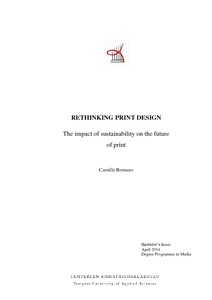Printed Electronics: Capabilities and Potentials for Intelligent Interactive Packaging
Ojuri, Babakolade Adefolu (2022)
Ojuri, Babakolade Adefolu
2022
Julkaisun pysyvä osoite on
https://urn.fi/URN:NBN:fi:amk-2022052411700
https://urn.fi/URN:NBN:fi:amk-2022052411700
Tiivistelmä
Printed Electronics as an emerging technology is a fast-evolving disruptive and enabling innovative technology that utilizes functional inks and conventional printing techniques for the mass production of flexible and low-cost devices. Printed Electronic (PE) is a rapidly evolving printing method in printing technology that enables the deposition of conductive inks easily at a low cost. Unlike the traditional microelectronics industry, this printing method is based on subtractive techniques.
Like any other emerging technologies, printed electronics have transitioned from the research stage to commercial production. The innovation advancement that enabled electronic printing on flexible unconventional substrates such as paper, thin films, plastics, and cardboards resulted in the production and introduction of a communication enhanced intelligent packaging into the market. The production of intelligent packaging was enabled by some of the properties of printed electronics: flexibility, lightweight, and low production cost. This resulted in printed electronics products such as printed displays, batteries, NFC tags, antennas, printed transistors, and resistors.
Printing electronics is an additive printing process capable of utilizing the same fictional materials as traditional manufacturing but is carefully deposited only in the needed areas on a chosen substrate through printing heads. Printed electronics depart from traditional electronics manufacturing (subtractive technique) that involves the deposit of functional layers through physical or chemical vapor. This is followed by multiple production steps involving using toxic chemicals to rid surplus metal layers. Printed electronics as a manufacturing process significantly eliminates the long traditional manufacturing steps, thereby reducing energy and waste generated.
In light of the above, this thesis, while be capitalizing on the properties of printed electronics at most, aims to explore the capabilities, characteristics, and potentials of printed electronics and its application for intelligent and interactive packaging, printing technology enablers such as the available printing methods, substrates, and functional materials. This research is based on an extensive literature review together with empirical observations. The findings of this thesis enumerate the value chain and the manufacturing process of printed technologies in the context and application of intelligent and interactive packaging.
Like any other emerging technologies, printed electronics have transitioned from the research stage to commercial production. The innovation advancement that enabled electronic printing on flexible unconventional substrates such as paper, thin films, plastics, and cardboards resulted in the production and introduction of a communication enhanced intelligent packaging into the market. The production of intelligent packaging was enabled by some of the properties of printed electronics: flexibility, lightweight, and low production cost. This resulted in printed electronics products such as printed displays, batteries, NFC tags, antennas, printed transistors, and resistors.
Printing electronics is an additive printing process capable of utilizing the same fictional materials as traditional manufacturing but is carefully deposited only in the needed areas on a chosen substrate through printing heads. Printed electronics depart from traditional electronics manufacturing (subtractive technique) that involves the deposit of functional layers through physical or chemical vapor. This is followed by multiple production steps involving using toxic chemicals to rid surplus metal layers. Printed electronics as a manufacturing process significantly eliminates the long traditional manufacturing steps, thereby reducing energy and waste generated.
In light of the above, this thesis, while be capitalizing on the properties of printed electronics at most, aims to explore the capabilities, characteristics, and potentials of printed electronics and its application for intelligent and interactive packaging, printing technology enablers such as the available printing methods, substrates, and functional materials. This research is based on an extensive literature review together with empirical observations. The findings of this thesis enumerate the value chain and the manufacturing process of printed technologies in the context and application of intelligent and interactive packaging.
Kokoelmat
Samankaltainen aineisto
Näytetään aineisto, joilla on samankaltaisia nimekkeitä, tekijöitä tai asiasanoja.
-
The Impact of Printing Orientation on The Tensile Properties of Parts Printed by Fused Deposition Modelling
Tran, Nhu (2019)This thesis work aims to study the relation between the tensile properties and print orientation of a PLA product produced by FDM printing process. The testing methods include tensile tests, analytical calculation and ... -
Implementing a new printing solution : FollowPrint
Tuominen, Toni (Tampereen ammattikorkeakoulu, 2016)This thesis was based on a project, whose purpose was to implement a new secure printing system to a company’s head office and two office locations in Tampere. The company whom this project was made for is one of the biggest ... -
Rethinking print design : The impact of sustainability on the future of print
Romano, Camille (Tampereen ammattikorkeakoulu, 2014)Sustainability is a current design topic of both interest and concern. After decades of scientific research, the environmental impact of human activity on nature is now widely recognized. Print, when it involves paper, is ...



